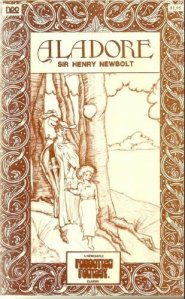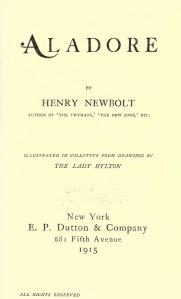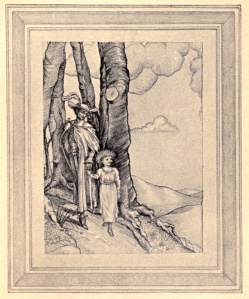Category: 3. Witnesses
Witnesses?
I can’t decide what to name the next section of this project. In the outline I called it “Get PDFs”, which is literally the goal. But, I want the process to be reflective, careful, and a bit methodical–not just a Google search for “aladore filetype:pdf” (you get some strange results for that one by the way…).
I have a background in Classical Studies where all the primary sources rely on the ancient art of Textual Criticism. The purposes of this project are much more simplistic–I want to produce a good reading copy, not a academic Critical Edition. None-the-less, I believe thinking about textual criticism is important here. I will devote at least a whole post to that thought soon, but for now I just want to borrow some terms:
Transmission: the text does NOT come from the authors mind/pen/typewriter to our eyes. It has a complex life in the physical world, being copied, edited, printed, etc etc.
Witnesses: these are the surviving documents, the physical manifestations of the text. Each has differing characteristics gained during its transmission.
Collation: gathering and comparing all known witnesses to understand the text’s history and create a best version.
For this project, we are really only interested in digitized copies of Aladore, rather than the complete publication and manuscript history. However, it is important to sort out how those digital texts relate the previous formats. In the ancient world of hand written scrolls the act of copying makes the perils of textual transmission obvious, but we face the same issues in publishing and digitization.
I still can’t decide, “Get PDFs” or “Witnesses” or…
how about, “3. Witnesses”
first witness
Aladore was first published, without illustrations (because Alice was taking too long), serially in Blackwood’s Magazine. Blackwood’s was originally considered a conservative magazine, but often featured “miscellany” from more radical poets, such as romantics Shelly and Coleridge. Part of this version of Aladore can be found online as a scan of the library bound volumes:
Blackwood’s Magazine, Vol. 195 (January to June 1914): https://archive.org/details/blackwoodsmagazi195edinuoft
Unfortunately, this volume includes only the first two installments (in May and June 1914). The rest of the story is in vol. 196 which is not available anywhere. There is a listing on Google books, however, it is one of those works that you can search and preview, but can not download. For no reason… its so frustrating! It has been scanned, all the other volumes are available for download, it is public domain, but… ?
It would be interesting to compare the serialized text to the one found in the publish books. However, since we do not have a complete text, I will probably forget about that for now.
Anyway, its worth mentioning that Henry was no stranger to the publishing and editing business. As mentioned, Margaret’s family were prominent publishers. Henry was also the editor of The Monthly Review (London: John Murray) from 1900 to 1904. Henry was the only official staff member–however, Ella did a huge amount of the work, living in London with Henry, while Margaret was with the children. The magazine featured literary and art reviews, check out an example edited by Henry here:
The Monthly Review, Vol. 3 (April to June 1901): https://archive.org/details/monthlyreview01wilgoog
Poe’s Blackwood articles
In the last post, I mentioned that Aladore was first published in Blackwood’s Magazine.
While researching the publication, I noticed that Edgar Allan Poe wrote two short humorous pieces ridiculing the overly sensation stories typical in these magazines. They were originally published as “The Psyche Zenobia” and “The Scythe of Time” in the The American Museum of Science, Literature, and the Arts (Baltimore: Brooks & Snodgrass) November 1838. The stories were retitled “How to write a Blackwood article” and “A Predicament” in later collections and can be found in a number of free online editions of Poe’s writing.
As a quick test project, I decided to make a mini ebook of these two short stories.
I used two source files (witnesses) that are in the Public Domain and easy to access:
1) An edited HTML version from Project Gutenberg in The Works of Edgar Allan Poe, Volume 4 (of 5) of the Raven Edition, eBook #2150, released 2008. http://www.gutenberg.org/ebooks/2150
2) A scanned copy of The Works of Edgar Allan Poe, Volume IV (New York: A.C. Armstrong & Son, 1884) available at Internet Archive. https://archive.org/details/worksofedgaralla04poeeuoft
To create the ebook, I used the great open-source editing software Sigil, which I will discuss in more detail in a future post. Unfortunately, the project is no longer actively developed, but for more info you can check out:
http://en.wikipedia.org/wiki/Sigil_%28application%29
https://github.com/user-none/Sigil
For this test project, I started with the HTML text from Project Gutenberg and checked it against the scanned original making edits and upgrades as needed. Sigil helps package everything together to create a proper EPUB file (more on epub another day). I created a quick cover from a screen shot of a scanned book page, and an automatic table of contents. Then I edited the embedded metadata file. Sigil automatically validates the EPUB, and it is good to go!
Unfortunately WordPress doesn’t allow upload of epubs, so I can’t just immediately share it here…
I need to find a good home for distributing the file, but for now I put it up on ge.tt.
Two stories by Edgar Allan Poe relating to that “justly celebrated publication” Blackwood’s Magazine: http://ge.tt/1FcuEHz1/v/0
Updated file location: Internet Archive, Community Text Collection, https://archive.org/details/PoeBlackwoodArticle
P.S. If you are sick of reading, some nice person also created a Public Domain audio book version of these two stories available at LibriVox:
https://librivox.org/two-poe-tales
P.S. I also forgot to mention that the stories are full of some stereotypes and language that is offensive to modern ears, as you might expect from nineteenth century satire…
PDF Poe
I just suddenly thought, even though this blog is all about creating epubs for ereaders, its actually a bit annoying to have an epub if you don’t have an ereader. So, I quickly converted the test Poe Two Blackwoods Stories epub into a PDF.
Converting EPUB into PDF is actually a bit harder than it should be. EPUBs are basically a zip file with the text contained in XHTML files. Like any web page there is no exact page layout encoded. So to create a PDF, the text must be laid out on a standard page format. One method is to create a CSS file that will add proper layout and formatting to your html, but it takes some tweaking to get it working correctly, and you still need a method to create a PDF from this layout. Ideally, as a book editor you would simply copy the text into a word processor/publishing program and do the layout by hand to ensure all the page breaks and formatting make sense.
However, I don’t want to spend a bunch of time re-editing this file!
The quickest automated conversion method is to use Calibre’s (free, open-source ebook manager, http://calibre-ebook.com) built-in conversion tool. However, you have to fiddle around with the settings a lot to get good results, because the converter is aimed at making a custom PDF designed for a specific screen size (i.e. your particular ereader or tablet), not a standard print PDF.
I used a different slightly silly work around:
Using 7-zip (free, open-source archive manager, http://www.7-zip.org) I extracted all the files from the epub (7-zip automatically recognizes epubs as zips). The actual text will appear inside a directory as XHTML files–in this case, there is one for each “chapter” of the book. I opened each with Firefox, and printed it as a PDF. However, I changed the print settings to make the font bigger and add some margins to the page. This crudely converts the free flowing epub text into a page layout. Then I took the PDF printout of each chapter and merged them into a single PDF. Finally, I edited the PDF metadata, just to try to be thorough about everything.
This creates a very basic PDF, basically recreating the look you would have on an ereader.
Since PDF is an accepted format at wordpress.com, I can share it right here:
New location for files
Okay, I decided to find a good home for the files I am creating… The best I can come up with is the Internet Archive (archive.org) Community Text Collection. If you are not familiar with the collections at the Internet Archive, it is definitely worth exploring. They are vast and fascinating, including everything from scans of historical books to live music bootlegs uploaded by fans (with permission from the bands). There is even a huge collection of broadcast TV and movies. The Wayback Machine provides access to their collection of archived websites–amazing and useful.
So here is the new page to download versions of the “Two Stories by Edgar Allan Poe relating to Blackwood’s Magazine” that I was using to test out some ideas:
https://archive.org/details/PoeBlackwoodArticle
Update: I noticed one odd/funny thing that Archive.org has done to my files. I first uploaded my hand made EPUB. Later I uploaded the PDF I created based on the EPUB. Archive.org assumes that the PDF is the original document, so it then automatically generated alternative formats based on the PDF–thus there is now a second EPUB, one that was generated by OCRing from my PDF! Very strange. I recommend downloading only my original EPUB, which has a file name and is 118.5 K.
Aladore in Print
Sorry for the tangent into Poe, but I think it gave us a good preview of future activities for this blog…
Now, back to Aladore, to examine the rest of the publication history.
A few posts ago I mentioned that Aladore was first published in Blackwood’s magazine in installments, with no illustrations.
When Alice Hylton’s illustrations were finally finished and ready for printing, Blackwood (Edinburgh and London: William Blackwood and Sons) published a limited de luxe edition of around 200 copies. These were apparently hand signed and sent friends.
I found one copy available at the Lilly Library at Indiana University. The catalog says the volume is signed, numbered 58 of 150, bound in vellum, and printed on handmade paper (xiv, 362, 15 illustration plates). http://iucat.iu.edu/catalog/1427136
At about the same time, Blackwood also printed the standard edition (Edinburgh and London: William Blackwood and Sons, 1914).
The following year the North American edition came out from Dutton (New York: E.P. Dutton & Company, 1915).
This was followed by a second Blackwood Edinburgh printing in 1916.
In all these editions the title page reads:
ALADORE
by HENRY NEWBOLT
AUTHOR OF “THE TWYMANS,’ ‘THE NEW JUNE,’ ETC.
ILLUSTRATED IN COLLOTYPE FROM DRAWINGS BY
THE LADY HYLTON
There is no mention of any revision for the different printings. On casual inspection they appear identical (we will look more closely at the digitized copies). There were no further editions for almost 60 years…
Forgotten Fantasy
…and 60 years later, the paperback came out!
Douglas Menville and Robert Reginald edited a plup magazine called Forgotten Fantasy: Classics of Science Fiction and Fantasy, which survived for only about a year in 1970-71. However, it spawned the Newcastle Forgotten Fantasy Library series which reprinted 24 significant and difficult to find works of early fantasy, including five from William Morris (for details see: http://home.epix.net/~wallison/nffl.html). In 1975, Aladore was reprinted as the 5th volume in the series (Hollywood (Calif.) : Newcastle, 1975). The book says it is a reprint of the 1915 Dutton edition.
Robert Reginald founded Borgo Press in the same year, which published a hardcover edition of Aladore in 1980 (San Bernardino, Calif. : Borgo Press, 1980). This version states that it is a reprint of the 1975 Newcastle edition.
There is no written mention of any editing or scholarship going into the production of the various editions of Aladore. This does not mean the text was completely unchanged of course, but I don’t expect there to be much variation between the witnesses.
Digitized Aladore
Finally, lets get some digital witnesses to work with!
There are basically two scanned books available online in many different versions with different processing.
First, is a copy of the 1914 Blackwood standard edition scanned at University of Toronto in 2006. Several different versions of the scanned book are available. U of T previously hosted PDFs on their own library website. You can still get their two versions from the legacy links, although the catalog no longer points to them:
U of T 1914 edition: http://scans.library.utoronto.ca/pdf/1/5/aladoren00newbuoft/aladoren00newbuoft.pdf
U of T 1914 edition, processed to black and white: http://scans.library.utoronto.ca/pdf/1/5/aladoren00newbuoft/aladoren00newbuoft_bw.pdf
The U of T library now points to Scholars Portal Books, hosted by the Ontario Council of University Libraries. The listing is here: http://books1.scholarsportal.info/viewdoc.html?id=75462
These PDFs are identical. They are large (57.2 MB) and well made.
Internet Archive also hosts a derivative of this scan. However, the PDF is much lower quality (10.9 MB) and has slow performance due to the odd layered post-processing. IA also provides automatically generated alternative formats, such as EPUB, but the accuracy of the transcription is horrible. On the upside, IA provides much more metadata than any of the other sites. https://archive.org/details/aladoren00newbuoft
Second, is a copy of the 1915 Dutton edition scanned at University of California Libraries in 2006. This copy exists in two versions online.
University of California Libraries point to the record on Hathi Trust Digital Library. Using Hathi can be annoying because they limit downloading many of their items, despite the fact that they are in the public domain. They have a sort of pay wall that requires logging in from a partner institution to access the full site. The second annoyance is that Hathi adds a huge border around the PDF pages that has a reference to the source file, plus a watermark over the bottom of the page. In this case the watermark says “Digitized by Internet Archive, Original from University of California.” Internet Archive does NOT include this watermark on their copy! Unfortunately, in providing this format, Hathi does not seem to consider READING and readers. It also seems a pathetic possessiveness over public domain materials. Color and black+white PDFs are available from the Hathi catalog listing, and are of high quality (119 MB): http://catalog.hathitrust.org/Record/006155073
Internet Archive also hosts a version of this scan, but again, their post-processing creates a lower quality (13.5 MB) and less useable PDF: https://archive.org/details/aladorehen00newbrich
Looking at the metadata provided by Internet Archive is really fascinating. The digitization of both editions were sponsored by Microsoft. One was shot using a Canon EOS 5D (at 400 ppi), the other a 1Ds (at 500 ppi)–almost certainly using an ATIZ BookDrive. The 1915 was shot November 7th 2006, and the 1914 was shot ten days later. The operators were “scanner-melissa-cunningham” and “scanner-katie-lawson.”
Even with all this random metadata, we do not know much about the digitization project or the post-processing. To me it is strange that we do not better document the process, to understand the intentions behind how these objects were created. It is interesting that the library catalogs do not represent ANY of the digitization metadata. The catalogs only refer to the original object and seem completely uninterested in the digital one or how it came into existence.
Publication history, summary
Just to summarize the last few posts, here is a full publication history of Aladore in one list.
Aladore, by Henry Newbolt:
- 1914 [serially published articles] Blackwood’s Magazine, Vol. 195-196.
Aladore, by Henry Newbolt, illustrated by Lady Hylton:
- 1914 [de luxe, limited edition] Edinburgh and London: William Blackwood and Sons.
- 1914 [standard edition] Edinburgh and London: William Blackwood and Sons.
- 1915 New York: E.P. Dutton & Company.
- 1916 Edinburgh and London: William Blackwood and Sons.
- 1975 [Newcasle Forgotten Fantasy Library, vol.5] Hollywood (Calif.): Newcastle.
- 1980 San Bernardino, Calif.: Borgo Press.
- 2006 digitized copy: New York: E.P. Dutton & Company, 1915.
- 2006 digitized copy: Edinburgh and London: William Blackwood and Sons, 1914.




